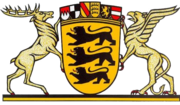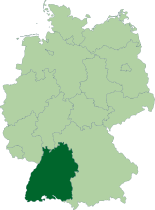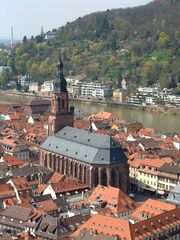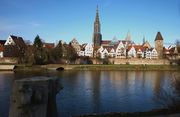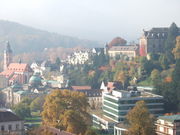Baden-Württemberg
|
||||||||||||||||||||||||||||||||||||||||||||||
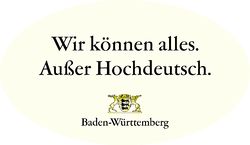
A campaign sticker, translated, "We can do anything except [speak] standard German." This is an allusion to the fact that Baden-Württemberg is one of the principal centres for innovation in Germany and has many inhabitants with distinctive dialects.
|
||||||||||||||||||||||||||||||||||||||||||||||
Baden-Württemberg (Alemannic German: Baade-Wiirdebäärg; German pronunciation: [ˈbaːdən ˈvʏɐ̯təmˌbɛɐ̯k]) is one of the 16 states of Germany. Baden-Württemberg is in the southwestern part of the country to the east of the Upper Rhine, bordering Alsace (France) to the west, Switzerland to the south, Bavaria to the east and northeast, Hessen to the north, and Rhineland Palatinate to the northwest.
Most of the major cities of Baden-Württemberg straddle the banks of the Neckar River, which runs centrally through the state (downstream (from southwest to the centre, then northwest) first Tübingen, then Stuttgart, Heilbronn, Heidelberg, and Mannheim). It is third largest in both area and population among the country's sixteen states, with an area of 35,742 square kilometers (13,800.1 sq mi) and 10.7 million inhabitants (both almost equivalent to all of Belgium). The state capital is Stuttgart.
The sobriquet Ländle (Low Alemannic and Swabian German dialect for "small land") is sometimes used as a synonym for Baden-Württemberg.
Contents |
History
The area used to be covered by the historical states of Baden, the Prussian Hohenzollern and Württemberg, part of the region of Swabia.[2]
Württemberg was occupied by the Romans in the 1st century A.D. who defended their position there by constructing a (limes) rampart. Early on in the 3rd century the Alemanni drove the Romans beyond the Rhine and the Danube, but in their turn they succumbed to the Franks under Clovis, the decisive battle taking place in 496. It later become part of the Holy Roman Empire.
After World War II Allied forces established three federal states: Württemberg-Hohenzollern, South Baden (both occupied by France), and Württemberg-Baden (US-occupied). In 1949 these three states became founding members of the Federal Republic of Germany. Article 118 of the new German constitution however had already prepared a procedure for those states to merge. After a plebiscite held on 9 December 1951 in four different regions, of which three approved the merger (South Baden refused, but was overruled as the result of total votes was decisive), the three states merged on 25 April 1952 into Baden-Württemberg.
In 1956 the Federal Constitutional Court of Germany ruled that the plebiscite was unlawful because it had disadvantaged Baden's population. The plebiscite was then held again within the area of former Baden in 1970 resulting in a majority of more than 81% for the new state.
Geography
The Rhine (German: Rhein) forms the western border as well as large portions of the southern border. The Black Forest (Schwarzwald), the main mountain range of the state, rises east of the Rhine valley. The high plateau Swabian Alb between Neckar, Black Forest and Danube is an important European watershed. Baden-Württemberg shares Lake Constance (Bodensee; the border with Switzerland is the middle of the lake) with Switzerland, the foothills of the Alps (known as the Allgäu) with Switzerland, Bavaria and Austria (Vorarlberg forms part of the southeastern bank of Lake Constance, but doesn't border Baden-Württemberg over land).
The Danube (Donau) river has its source in Baden-Württemberg near the town of Donaueschingen, in a place called Furtwangen in the Black Forest.
Administration
Baden-Württemberg is divided into 35 districts (Landkreise) and 9 independent cities (Stadtkreise), both grouped into the four Administrative Districts (Regierungsbezirke) of Freiburg, Karlsruhe, Stuttgart, and Tübingen.

Map
|
|
Furthermore there are nine independent cities, which do not belong to any district:
A. Baden-Baden
B. Freiburg
C. Heidelberg
D. Heilbronn
E. Karlsruhe
F. Mannheim
G. Pforzheim
H. Stuttgart
I. Ulm
Economy
Baden-Württemberg is among the most prosperous states in Germany[2] and is one of the wealthiest regions in Europe with a traditionally low unemployment rate. A number of well-known enterprises are headquartered in the state, for example Daimler AG, Porsche, Robert Bosch GmbH (automobile industry), Carl Zeiss AG (optics), and SAP AG (largest software enterprise in Europe). In spite of this, Baden-Württemberg's economy is dominated by small and medium-sized enterprises. Although poor in workable natural resources (formerly lead, zinc, iron, silver, copper and salts) and still rural in many areas, the region is heavily industrialized. In 2003, there were almost 8,800 manufacturing enterprises with more than 20 employees, but only 384 with more than 500. The latter category accounts for 43% of the 1.2 million persons employed in industry. The Mittelstand or mid-sized company is the backbone of the Baden-Württemberg economy.[3] Medium-sized businesses and a tradition of branching out into different industrial sectors have ensured specialization over a wide range. A fifth of the "old" Federal Republic's industrial gross value added is generated by Baden-Württemberg. Turnover for manufacturing in 2003 exceeded 240,000 million, 43% of which came from exports. The region depends to some extent on global economic developments, though the great adaptability of the region's economy has generally helped it through crises. Half of the employees in the manufacturing industry are in mechanical and electrical engineering and automobile construction. This is also where the largest enterprises are to be found. The importance of the precision mechanics industry also extends beyond the region's borders, as does that of the optical, clock making, toy, metallurgy and electronics industries. The textile industry, which formerly dominated much of the region, has now all but disappeared from Baden-Württemberg. Research and development (R&D) is funded jointly by the State and industry. In 2001, more than a fifth of the 100,000 or so persons working in R&D in Germany were located in Baden-Württemberg, most of them in the Stuttgart area.[4] Baden-Württemberg is also one of the Four Motors of Europe.
A study performed in 2007 by the pr campaign "Initiative for New Social Market Economy" (German: Initiative Neue Soziale Marktwirtschaft (INSM)) and the trade newspaper "Wirtschaftswoche" awarded Baden-Württemberg for being the "economically most successful and most dynamic state" among the 16 states.
Tourism
Baden-Württemberg is a popular holiday destination, rivaled in Germany only by Bavaria in terms of its natural landscapes and variety of culinary and cultural offering and its possibilities for outdoor activities.[2] Main sights include the capital and biggest city, Stuttgart, modern and historic at the same time, with its urban architecture and atmosphere (and famously, its inner city parks and historic Wilhelma zoo), its castles (such as Castle Solitude), its (car and art) museums as well as a rich cultural programme (theatre, opera) and mineral spring baths in Stuttgart-Bad Cannstatt (also the site of a Roman Castra), the residential (court) towns of Ludwigsburg and Karlsruhe, the spas and casino of luxurious Baden-Baden, the medieval architecture of Ulm (Ulm Cathedral is the tallest church in the world), the vibrant, young, but traditional university towns of Heidelberg and Tübingen with their old castles looking out above the river Neckar, sites of former monasteries such as the ones on Reichenau Island and at Maulbronn (both World Heritage Sites) as well as Bebenhausen Abbey, the lush Upper Neckar valley (where Rottweil is famous for its carnival (Fastnacht)) and the pristine Danube valley, rich old Free Imperial Cities such as Biberach, Esslingen am Neckar, Heilbronn, Ravensburg, Reutlingen and Schwäbisch Hall, and the southernmost and sunniest city of Germany, Freiburg, close to Alsace and Switzerland, being an ideal base for exploring the heights of the nearby Black Forest (e.g. for skiing in winter or for hiking in summer) with its traditional villages and the surrounding wine country of the Rhine Valley of South Baden.[2] The countryside of the Swabian Alb (with Hohenzollern Castle), the largely pristine Swabian Forest, the Rhine Valley and Lake Constance (German: Bodensee), where all kinds of water sports are popular, with the former Imperial, today border town of Konstanz (where the Council of Constance took place), the Neolithic and Bronze Age village at Unteruhldingen, the flower island of Mainau, and the hometown of the Zeppelin, Friedrichshafen a.o., are especially popular for outdoor activities in the summer months.[2]
In spring and autumn (April/May and September/October), beer festivals (fun fairs) are taking place at the Cannstatter Wasen in Stuttgart; the one in the autumn, the Cannstatter Volksfest, is the second biggest such festival in the world after the Munich Oktoberfest. In late November/early December, Christmas markets are a tourist magnet in all major towns, with the biggest one in Stuttgart, lasting for the three weeks prior to Christmas.
Education
Baden-Württemberg is home to some of the oldest, most renowned and prestigious universities in Germany, such as the universities of Heidelberg, Freiburg and Tübingen. It also contains four of the nine German 'excellence universities' (Heidelberg, Freiburg, Karlsruhe, and Konstanz).
Other university towns are Mannheim and Ulm. Furthermore, two universities are located in the state capital Stuttgart, the University of Hohenheim and the University of Stuttgart. Ludwigsburg is home to the renowned national film school Filmakademie Baden-Württemberg (Film Academy Baden-Wuerttemberg). The private International University in Germany is situated in Bruchsal. There is another private university, located in Friedrichshafen, Zeppelin University.
Furthermore, there are more than a dozen Fachhochschulen, i.e. universities of applied sciences, as well as Pädagogische Hochschulen, i.e. teacher training colleges, and other institutions of tertiary education in Baden-Württemberg (a.o. in Aalen, Esslingen, Ludwigsburg, Nürtingen, Pforzheim, Ravensburg-Weingarten, Reutlingen, several in Stuttgart, Schwäbisch Hall).
The state has the highest density of academic institutions of any territorial state (i.e. excluding Berlin and Hamburg) in Germany.
Language
Two dialect groups of German are spoken in Baden-Württemberg in various variants: Alemannic and Franconian dialects. In southern and central Württemberg, the Alemannic dialect of Swabian is spoken (slightly differing even within the area, e.g. between Upper Swabian, the Alb Swabian and the central Neckar Valley variant of the Stuttgart region). In South Baden, the local dialects are Low Alemannic and High Alemannic (i.e. variants of what is also Swiss German). In the northern part of Baden, i.e. the former Kurpfalz (Electoral Palatinate) with the capital Heidelberg, the idiom is Rhine Franconian (Kurpfälzisch, i.e. Palatinate German), while in the Northeast (around Schwäbisch Hall) East Franconian is spoken.
The same or similar Alemannic dialects are also spoken in the neighbouring regions of Bavarian Swabia, Alsace (Alsatian), German-speaking Switzerland (Swiss German), Liechtenstein, Vorarlberg, small parts of Tyrol and the Piemont and Aosta Valley (Walliser German), while other Franconian dialects are spoken in the Palatinate, parts of Hessen and the Rhineland and in Franconia.
see also Alemannic separatism
Demographics
The population of Baden-Württemberg is 10,749,755 (2008), of which 5,466,966 is female and 5,282,789 is male, total population up 0.10 per cent over a year earlier. This was due to more births than deaths. In 2006, the birth rate was 8.61 per 1000, lower than that of 8.80 per 1000 in 2005. The death rate decreased from 8.80 per 1000 in 2005 to 8.60 per 1000 in 2006. In 2008, Nearly 14.87 percent of the population under the age of 15, fell from 15.13 per cent over a previous year. The proportion of people aged 65 and over rose from 18.72 per cent to 18.99 per cent. Correspondingly, the median age (aged 15–64) of the population fell from 66.15 to 66.14 over the same period. The ratio of people aged under 15 and aged 65 and over to the population of working age (aged 15–64), the overall dependency ratio is 512 per 1000 in 2008. The Sex ratio of total population is 0.966 male(s)/female.
Religion
While Northern and most of central Württemberg has been traditionally Lutheran-Protestant (later also Pietist) since the Reformation that was adopted there in 1534 (with its centre at the famous Tübinger Stift) and the former Electoral Palatinate (Northwestern Baden) with its capital Heidelberg was shaped by Calvinism before being integrated into Baden, Upper Swabia, the Upper Neckar Valley up to the bishop seat of Rottenburg and Southern Baden (the Catholic archbishopric has its see in Freiburg) have traditionally been bastions of Catholicism.
| Religion | % | |
|---|---|---|
| Roman Catholics | 36.9%[5] | 4.0M |
| Evangelical Church in Germany | 33.3%[6] | 3.6M |
| Muslims | 5.6% | 600 000 |
| Buddhists | 0.23% | 25 000 |
| Hindu | 0.14% | 15 000 |
| Jews | 0.08% | 9 000 |
| Non Religious | 22.3% | 2.4M |
Religious Freedom Controversy
Baden-Württemberg was the first of Germany's 16 states to outlaw the wearing of headscarves by Muslim teachers at state schools after a similar ban in France in 2004. Several resultant cases received international attention.
In one prominent example, one of the women affected, Doris Graber, had been teaching since 1973 but began wearing a headscarf in 1995. On March 18, 2008, a German court ruled that she could not wear a headscarf despite her argument that she should be permitted to do so under equal treatment laws since nuns were allowed to teach in a public school at that time while wearing religious habits.[7] The state attorney spoke of a "historic exception" in the aforementioned public school where the nuns still teach in habit.[7] The school, a former monastery, was taken over by the state and authorities are bound to a contract governing the "exceptions status" of the school.[7]
Politics
The politics of Baden-Württemberg are dominated by the conservative Christian Democratic Union of Germany (CDU), who have led all but one government since the establishment of the state in 1952. The CDU currently have a minority of one in the state assembly, and rule in coalition with the liberal Free Democratic Party. The opposition is led by the leftist Social Democratic Party of Germany and the Alliance '90/The Greens party. Until 2001 the anti-immigration The Republicans party also had seats in the state assembly.
See also
- Baden, for the pre-19th century state
- History of Baden
- Origin of the coats of arms of German federal states
- Grand Duchy of Baden, for the state that existed from 1808–1918
- Republic of Baden, for the state that existed from 1918–1945
- Rulers of Baden, for a list of sovereigns and presidents
- List of places in Baden-Württemberg
- Four Motors of Europe
Footnotes
- ↑ "Bevölkerung und Erwerbstätigkeit" (in German). Statistisches Landesamt Baden-Württemberg. 31 December 2009. http://www.statistik.baden-wuerttemberg.de/Veroeffentl/Statistische_Berichte/3126_09001.pdf.
- ↑ 2.0 2.1 2.2 2.3 2.4 Andrea Schulte-Peevers; Anthony Haywood, Sarah Johnstone, Jeremy Gray, Daniel (2007). Germany. Lonely Planet. ISBN 9781740599887. http://books.google.com/books?id=Z5t5mZE_s5YC&pg=PA392#PPA391,M1. Retrieved 2009-02-01.
- ↑ Cooke, p. 84
- ↑ "BADEN - WÜRTTEMBERG - Economy". Eurostat. June 2004. http://circa.europa.eu/irc/dsis/regportraits/info/data/en/de1_eco.htm. Retrieved 2009-01-16.
- ↑ chiesa cattolica http://www.dbk.de/imperia/md/content/kirchlichestatistik/bev-kath-l__nd-2008.pdf
- ↑ EKD http://www.ekd.de/download/kirchenmitglieder_2007.pdf
- ↑ 7.0 7.1 7.2 "German Court Upholds School Ban on Muslim Headscarf". Deutsche Welle. 2008-03-18. http://www.dw-world.de/dw/article/0,2144,3200819,00.html. Retrieved 2009-01-14.
References
- Philip Cooke, Kevin Morgan (1998). The Associational Economy: Firms, Regions, and Innovation. Oxford University Press. p. 84. ISBN 9780198296591.
External links
|
|||||||||||||
|
||||||||

